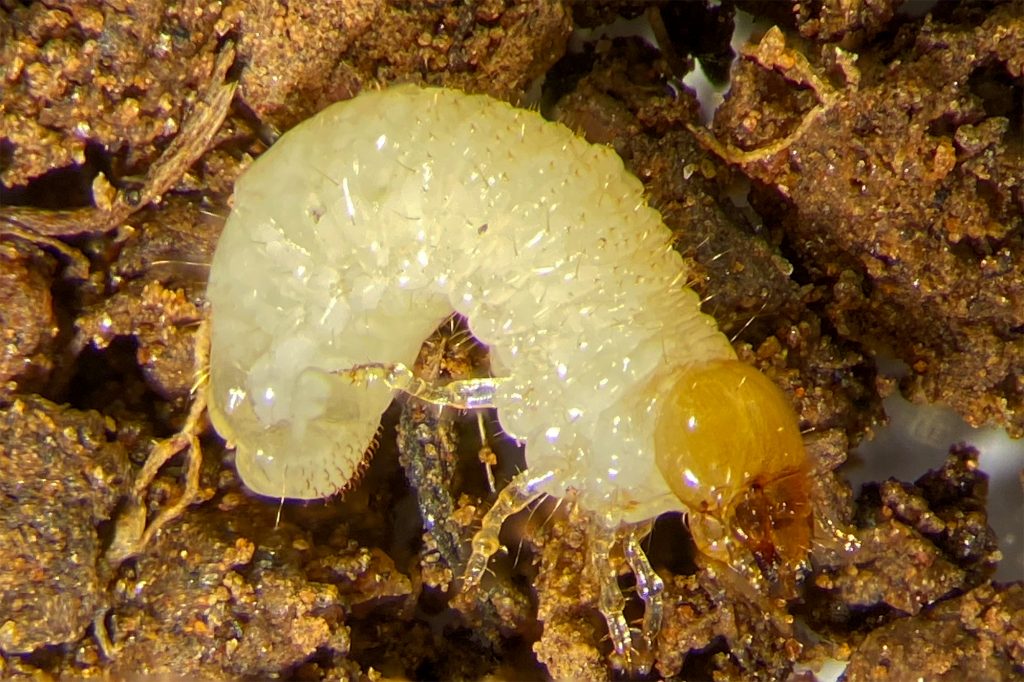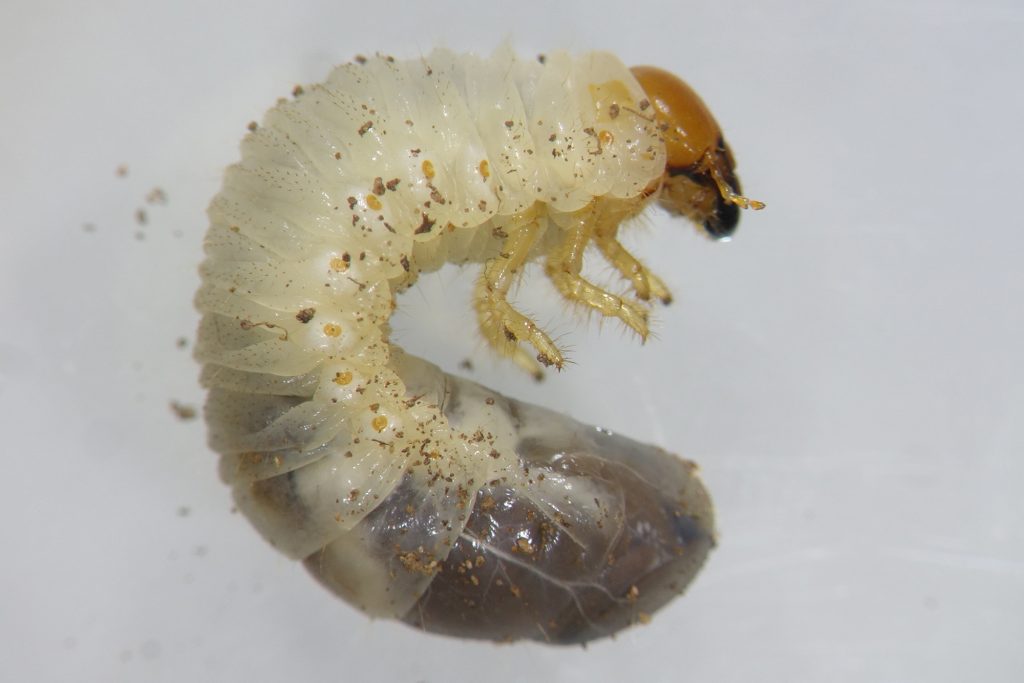When finding scarab grubs or ‘cockchafers’ in your paddock, do you look at their head colour to figure out the species?
While at least three pest species in south-eastern Australia have the common names ‘blackheaded pasture cockchafer’, ‘redheaded pasture cockchafer’ and ‘yellowheaded cockchafer’, focusing on head colour alone can be misleading.
Scarabs have recently been reported in some paddocks in Victoria and southern New South Wales; in this article we’ll outline why head colour can be misleading and highlight some alternative key features for accurate identification.
Scarabs and cockchafers
The term scarab generally refers to a taxonomic rank of beetles – the ‘Scarabaeidae’ family.
In the immature form (larvae), scarabs are generally C-shaped grubs with 3 pairs of true legs located near their head. Their head is a hardened capsule which has large, visible mouthparts. Their C-shape is most obvious at rest; when scarab larvae burrow or walk, their bodies extend longitudinally.
In the adult form, scarabs are no longer grub-like, rather they are winged, robust and hardened beetles. The two features that distinguishes them from other beetles is their clubbed antennae and the serrated appearance of their legs.
The term ‘cockchafer’ is not an official taxonomic rank or defined by specific features, rather it is the common name for some species of scarabs.
Not all scarabs that have the common name ‘cockchafer’ are pests.
Likewise, there are pest species of scarabs which don’t have the term ‘cockchafer’ in their common name.
The problem with head colour
As some key scarab pest species in south-eastern Australia are named ‘blackheaded pasture cockchafer’, ‘redheaded pasture cockchafer’ and ‘yellowheaded cockchafer’, head colour often sways identification.
However, approaching scarab identification through this trichotomy is misleading for several reasons:
1. Head colour is ambiguous
Colour perception varies between people. What one person calls red, another calls orange or brown, or even yellow.
For example, redheaded pasture cockchafers were recently reported pruning the roots of grazing wheat in the NSW Riverina, however on closer inspection of characteristics other than head colour, they were in fact yellowheaded cockchafers.
Relying on head colour alone for scarab identification has time and again resulted in misidentifications.
2. Some scarab pest species aren’t named after their head colour
Redheaded, yellowheaded or blackheaded cockchafers are not the only pest species in southern regions of eastern Australia.
For example, in late April, some large scarab larvae were discovered in high numbers pruning the roots of an established lucerne stand in Central West NSW. From their head colour, the redheaded pasture cockchafer was the first suspect, however after receiving an image and a sample, we identified them as the Argentinian scarab (Cyclocephala signaticollis), a notorious turf pest of which little is known.
African black beetle (Heteronychus arator) is also a key pest species in pastures and some crops, and could be mistaken with redheaded pasture cockchafers.
3. Misidentification with non-pest species
There are many scarab species in Australia, and only a small fraction are agricultural pests.
Dung beetles are non-pest scarabs, and these beneficial soil engineers are often found on farms, particularly those with livestock.
Non-pest species can have head capsules that are similar in colour to pest species; finding a C-shaped grub in paddocks prior to sowing or even near plant damage is not enough to point the finger on its own.
For example, tiny scarab larvae with yellow heads were recently found near heavily chewed young ryegrass plants. Despite their yellow head, they were not yellowheaded cockchafers. These scarabs belonged to a family of small dung beetles, Aphodinae, and were unlikely the cause of the damage. Aphodinae scarabs are largely species that feed on dung or decaying organic matter; the only recognised pest species of Aphodinae in Australia is the blackheaded pasture cockchafer.
Correct identification can mean the difference between knowing when to act, and knowing when to let ecological processes continue.

A closer look at key scarab species
Correct identification of scarab pests is crucial.
Although there is some cross over in management techniques between pest scarabs, some species have specific control options.
For example, most scarab larvae don’t emerge above ground and are notoriously hard to contact with insecticides. The exception is blackheaded pasture cockchafer larvae, which leave their underground tunnels to feed on pasture above ground after a rainfall or a heavy dew. That’s why the blackheaded pasture cockchafer is one of the very few scarab pests which can be controlled with insecticides.
Apart from head colour, other features which are useful for identification include, head texture, rear hair pattern/or the shape of the opening on their rear.
Here are the key features to look out for key agricultural scarab pests:
Redheaded pasture cockchafer – Adoryphorus coulonii
Key features:
- A red head that is pitted
- Opening on rear is a horizontal slit
- Rear opening has a fringe of longer hairs

Photo by Andrew Weeks, Cesar Australia 
Photo by Andrew Weeks, Cesar Australia
Blackheaded pasture cockchafers – Acrossidius tasmaniae
Key features:
- A black-brown head that is smooth (not pitted)
- A unique hair arrangement like round brackets ‘( )’ on rear
- Opening on is a horizontal slit

Photo by Andrew Weeks, Cesar Australia 
Photo by Cesar Australia
Yellowheaded cockchafers – Sericesthis spp.
Key features:
- A yellow-orange head that is smooth (not pitted)
- Opening on rear is an inverted ‘Y’ shape

Photo by Andrew Weeks, Cesar Australia 
Photo by Cesar Australia
African black beetle – Heteronychus arator
Key features:
- An orange head that is smooth (not pitted)
- Opening on rear is a horizontal slit
- There is a bald patch between hairs at rear, which runs perpendicular to the slit
- Final spiracle on body (crescent-shaped plates visible on side) is much smaller than the preceding spiracles

Photo by Julia Severi, Cesar Australia 
Photo by Cesar Australia
Argentinian scarab – Cyclocephala signaticollis
Key features:
- An orange head that is smooth (not pitted)
- Opening on rear is a horizontal slit
- A patch of very coarse hairs near slit
- Final two spiracles on body (crescent-shaped plates visible on side) are larger than the preceding spiracles

Photo by Julia Severi, Cesar Australia 
Photo by Cesar Australia
Acknowledgements
Thanks to the following for providing scarab field observations: Jim Cronin (Nutrien Ag Solutions), Jono Nicoll (Elders), David White (Delta Ag), Glenn Sheperd (IMAG Agronomy), Andrew Parr (Murray Valley Rural), Rebecca Bingley (MG Trading).
Cover image: Photo by Paul Umina, Cesar Australia





